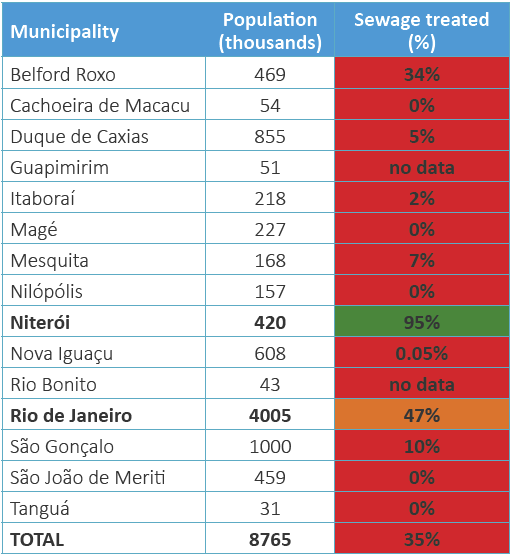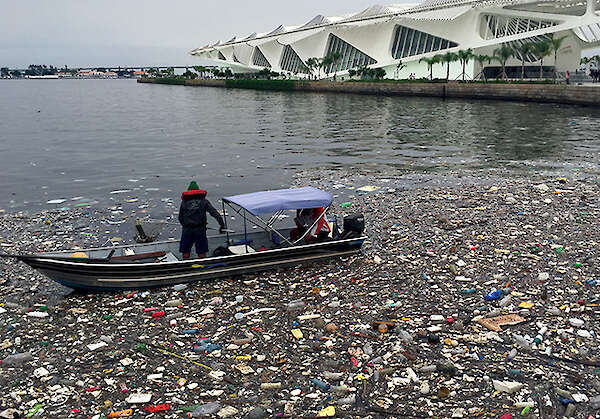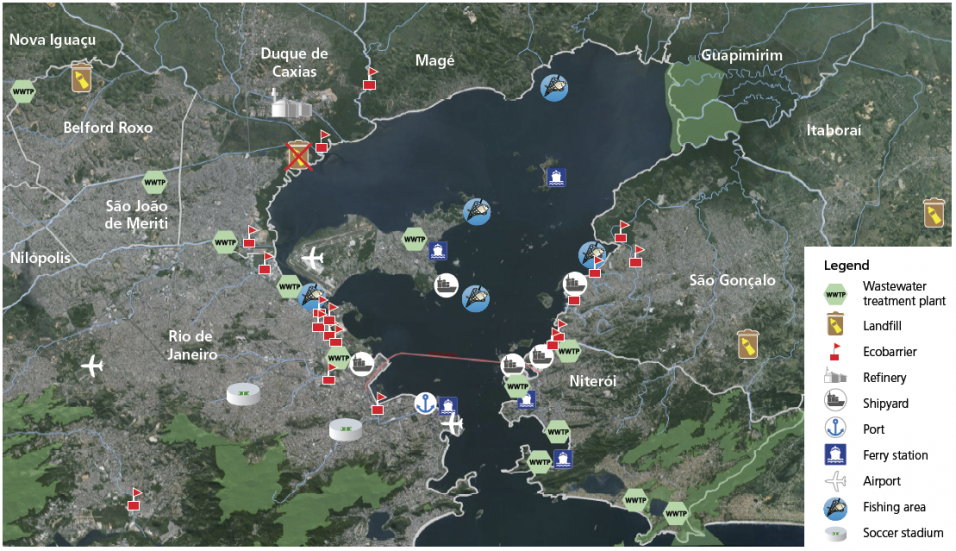Access to sewage treatment and trash collection greated needed throughout Guanabara Bay
A lack of sewage collection and treatment surrounding Guanabara Bay has led to a number of problems for both people and the environment. Untreated sewage entering the Bay contributes to the high levels of bacteria in the water. This makes the water unsuitable for recreation activities, swimming, fishing, and boating.


Of the total amount of sewage generated in Niteroi in 2014, 95% of it was collected and treated, by a private company, but the sewage is not fully treated and is discharged directly into the Bay where it still contributes to water quality problems. The next highest amount of sewage treatment was in Rio de Janeiro, with 47% of sewage treated. The total amount of sewage treatment for all municipalities combined was only 35% in 2014.
Trash collection and disposal is another long standing problem in Guanabara Bay. Without trash services available, tons of trash ends up in the Bay which negatively impacts human health, recreation, tourism, fisheries, and the environment. Ecobarriers have been collecting floating trash over the last two years in the tributaries of Guanabara Bay. By August 2016, a total of 17 ecobarriers were implemented. While they help keep trash out of the Bay, it is still important to dispose of trash properly so it does not reach the rivers.

The values of Guanabara Bay are under threat
Guanabara Bay is a beautiful natural harbor that forms the identity of the Rio de Janeiro region. The Bay supports the Brazilian economy, through activities like shipping, recreation, and tourism. Urban development results in significant impacts including litter and untreated sewage leading to bacterial contamination. In addition, industrial and agricultural development can result in contaminated runoff.

Workshop stakeholders recognize need for action
During the development of the report card, participants at workshops gave feedback about Guanabara Bay values, threats, and restoration efforts. Each person was asked to use four words to describe the Bay. The results were compiled into a word cloud where the dominant words were beautiful, polluted, dynamic, unique, dirty, important, and alive. The participants concluded that while the conditions in Guanabara Bay are challenging, they are committed to enhancing, restoring, and protecting the Bay for future generations.

This word cloud describes how participants feel about the state of Guanabara Bay.
Your actions can make a difference!
You can and must, before everything, become an owner of Guanabara Bay. It is yours! Most of the communities surrounding the Bay do not know that they are near one of the most beautiful bays in the world. The Bay is degraded, that is true. However, by working together, we can all help improve the health of Guanabara Bay.
 Properly dispose of trash – The trash from your house, if not collected, ends up in rivers which flow into the Bay. You can help by only throwing your trash in authorized places, where it will be collected by the City. Help keep your neighborhood clean!
Properly dispose of trash – The trash from your house, if not collected, ends up in rivers which flow into the Bay. You can help by only throwing your trash in authorized places, where it will be collected by the City. Help keep your neighborhood clean!
 Plant trees – Planting trees and native shrubs helps support the Bay. During storms, runoff from city streets flows into the rivers and the Bay. When there are green spaces in the city the water can be naturally filtered before it reaches the Bay. Green spaces like parks also help make our communities more beautiful and enjoyable.
Plant trees – Planting trees and native shrubs helps support the Bay. During storms, runoff from city streets flows into the rivers and the Bay. When there are green spaces in the city the water can be naturally filtered before it reaches the Bay. Green spaces like parks also help make our communities more beautiful and enjoyable.
 Become a stakeholder – Get involved by participating in your neighborhood associations, local watershed committees, non-governmental organizations, and volunteer programs. Talk to your neighbors about the Bay and why it is important for everyone.
Become a stakeholder – Get involved by participating in your neighborhood associations, local watershed committees, non-governmental organizations, and volunteer programs. Talk to your neighbors about the Bay and why it is important for everyone.

Protect river banks – River banks are protected areas in Brazil because they control river volume, water quality, and protect against flood events. Construction near rivers prevents natural ecosystem services the river banks provide. It is illegal to build on or near river banks.
